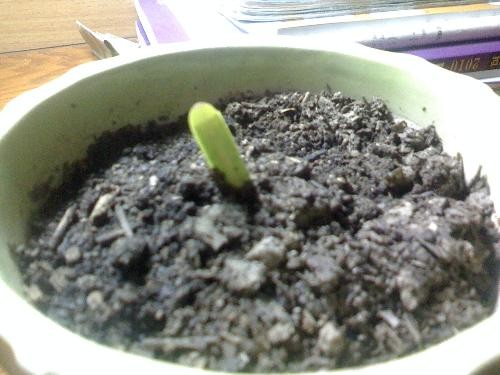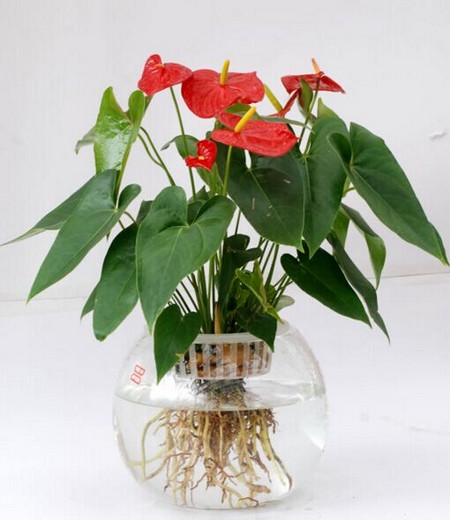Culture methods and matters needing attention of potted Anthurium andraeanum
How to raise Anthurium andraeanum? What are the breeding methods and matters needing attention of Anthurium andraeanum? Friends who like to cultivate Anthurium andraeanum will first have such doubts. We need to note that among all flowers, Anthurium andraeanum is very sensitive to salt. The shape of Anthurium andraeanum is unique, the leaves are emerald and green, and the fiery red inflorescence is placed on it, and the collocation of red and green is so eye-catching. For the question of how to raise Anthurium andraeanum, many people are still at a loss. The following editor will introduce the breeding method of Anthurium andraeanum to you!
Flowerpot:
The production of flowerpots often uses dark red plastic pots, which can be cultivated in plastic flowerpots with changing colors in order to coordinate with home decoration. When Anthurium andraeanum plantlets or tissue culture seedlings have 2 leaves, they can be transplanted into pots with a diameter of 9 cm, with 1 plant in each pot. When the basin is full, it can be planted in the basin with a diameter of 16-20 cm.
Soil:
The soil of Anthurium andraeanum must be kept permeable without stagnant water. When family farming, you can choose to buy prepared culture soil in the horticultural shop and add a small amount of ceramsite or dried bark (ceramsite: dry bark = 2:1). Disinfect the soil before planting (if you buy professional soil, you can save this step) to prevent Anthurium andraeanum from suffering from diseases and insect pests in the later stage of growth.
Temperature:
The most suitable growth temperature of Anthurium andraeanum is 14-35 ℃. In winter, Anthurium andraeanum is easy to be frostbitten when the temperature is below 10 ℃, so pay attention to increase the temperature in time. In summer, when the temperature is higher than 35 ℃, water should be sprinkled around Anthurium andraeanum to cool down.
Humidity:
High temperature and humidity are beneficial to the growth of Anthurium andraeanum. Humidity is often related to temperature. When the indoor temperature is higher than 28 ℃, it is necessary to increase indoor humidity. Humidifier or sprinkler can be used to humidify; when the temperature is lower than 20 ℃, the indoor environment humidity can be maintained. In winter, when the indoor temperature is higher, it is not easy to cool and moisturize too much. Excessive humidity of plant leaves at night will reduce its ability to protect against cold and make it frostbite, which is not conducive to winter.
Watering:
Water Anthurium andraeanum according to the dryness of the basin soil. Water is watered every 3 days in spring and autumn; high temperature in summer is recommended to spray on the leaves at noon to increase or decrease humidity; in winter, water can be watered every 5-7 days. When the weather is cold, watering should be chosen again when the temperature is higher, and it is most appropriate to water between 9: 00 a.m. and 4: 00 p.m., so as not to frostbite the roots. Pay attention to watering, watering should be dry and wet alternately to avoid watering in the case of serious lack of water, so as not to affect the growth and development of Anthurium andraeanum.
Anthurium andraeanum likes moist soil and high air humidity. Spring, summer, autumn growth season to keep the basin soil wet, while often to its leaves and around spray, in order to increase air humidity. When the temperature dropped to about 18 ℃ at the end of autumn, the water supply was gradually reduced, which made the basin soil moist. Winter is the flowering season, can not lack of water, but because of the low temperature in winter, watering should not be more, to keep the basin soil moist, at the same time, because the indoor air humidity is low, should pay attention to its leaf and around spray several times. If arranged in an air-conditioned room, the number of sprays should be increased. Be careful not to spray water on the flowers when they bloom.
Fertilization:
Anthurium andraeanum is a fertilizer-loving plant, which has a higher demand for magnesium fertilizer than other plants. It is recommended to go to the florist to buy foliar fertilizer with high magnesium content, or choose water-soluble compound fertilizer to dilute it into liquid fertilizer and spray it once a week during the growth period. When applying fertilizer, we should adhere to the principle of applying thin fertilizer frequently, preferring less than more.
Anthurium likes to be fat, but it is not resistant to thick fertilizer. No fertilizer was applied when the temperature was low in late autumn, winter and early spring, and topdressing began after new leaves grew in spring, and 10 times of rotten liquid fertilizer mixed with 1000 times of potassium dihydrogen phosphate or 1000 times of "Huaduoduo" general fertilizer was applied every 10 days. Fertilization was stopped when the temperature dropped to 15 ℃ at the end of autumn.
Trim:
Cut off the withered and yellow leaves and diseased leaves in time during the growing period, and remove some old leaves when the leaves are too dense. Cutting off old leaves can also promote the growth of new leaves.
Pest control:
The most common pests of Anthurium andraeanum are red spider, nematode, cabbage worm, whitefly, thrips, snail and shell worm, especially red spider, nematode and cabbage worm. However, Anthurium andraeanum is sensitive to insecticides. in the process of family maintenance, we try to choose low concentrations of pesticides to kill pests, paying special attention to pesticides containing copper and dimethoate, methamidophos, dichlorvos, malathion, parathion, etc., which are toxic to Anthurium andraeanum. It is recommended not to use it.
Note:
1. It is difficult to blossom if there is not enough sunshine
Anthurium likes the sun. If there is not enough sunlight during the growing period, it is difficult to blossom, but it is not suitable for direct sunlight, and there will be leaf burning. The best way is to put it in a bright shady place, which can be protected from both strong and refracted sunlight.
2. It is difficult to feed when the temperature is uncomfortable.
Anthurium andraeanum culture should pay attention to temperature control, its suitable temperature for growth is 18 ℃-- 28 ℃, the highest temperature should not exceed 35 ℃, the lowest temperature is 14 ℃, freezing injury may occur at any time below 10 ℃, so high temperature in summer should pay attention to ventilation and watering, and greenhouse culture should be carried out in winter.
3. Humidity, proper posture and beauty
Anthurium andraeanum in culture should pay attention to moisturizing, if you can correctly control the humidity needed during the growing period of Anthurium andraeanum, it can make Anthurium grow healthily, the petals are fiery red, extremely bright, and the posture is very beautiful.
4. For pot soil, it is better to use 6 parts of rotten leaf soil, 3 parts of river sand (or perlite) and 1 part of organic fertilizer such as rotten cow manure or chicken manure. When it was planted in the pot. The bottom of the basin is filled with soft broken bricks and other materials with a depth of 1 pound, 4 grains and 3 grains, so as to facilitate the drainage of basin soil.
Time: 2019-06-01 Click:
- Prev

Culture method of Bedanhua
The other shore flower is not only beautiful in appearance, but also has high medicinal value. It is deeply loved by flower and tree breeders. Before raising the other shore flower, it is necessary to understand the growth habits of the other shore flower. In addition to seed reproduction, it can also use its bulb to reproduce.
- Next

How to cultivate Anthurium andraeanum in Aquatic Culture (method)
Anthurium andraeanum is not only a plant of Araceae, but also a kind of hydrophilic plant. But hydroponics is a little more difficult. In the hydroponic culture of Anthurium andraeanum, half of the roots should be exposed to the air, so that the roots can breathe in the air "as shown", otherwise, it will easily lead to rotting roots. Root exposure growth of hydroponic plants
Related
- Fuxing push coffee new agricultural production and marketing class: lack of small-scale processing plants
- Jujube rice field leisure farm deep ploughing Yilan for five years to create a space for organic food and play
- Nongyu Farm-A trial of organic papaya for brave women with advanced technology
- Four points for attention in the prevention and control of diseases and insect pests of edible fungi
- How to add nutrient solution to Edible Fungi
- Is there any good way to control edible fungus mites?
- Open Inoculation Technology of Edible Fungi
- Is there any clever way to use fertilizer for edible fungus in winter?
- What agents are used to kill the pathogens of edible fungi in the mushroom shed?
- Rapid drying of Edible Fungi

